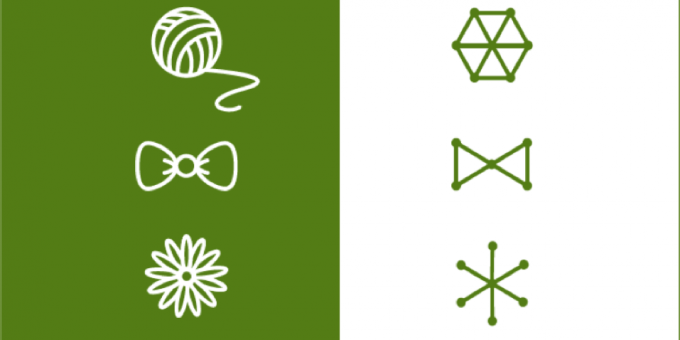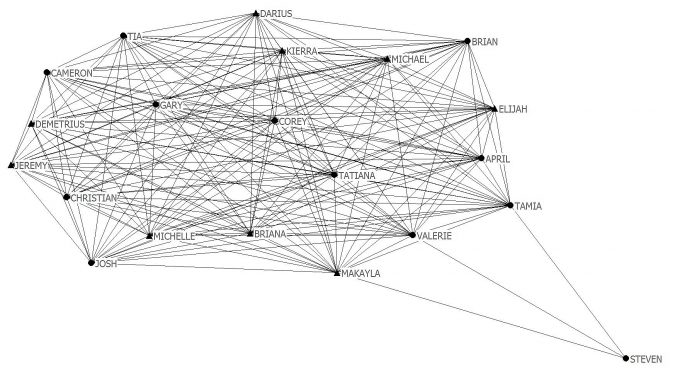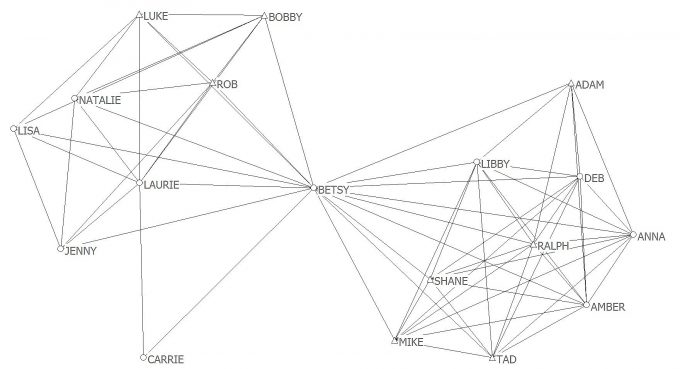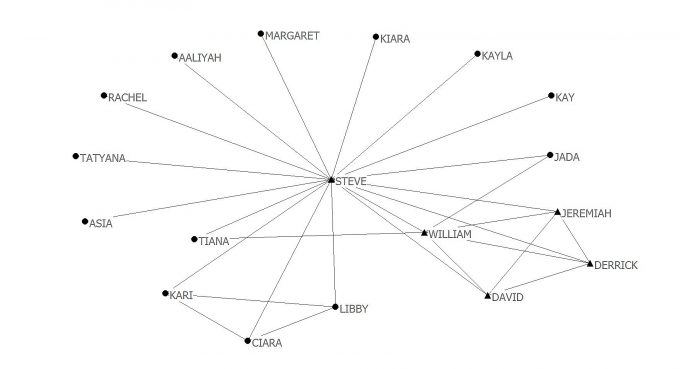
Friends with Academic Benefits
“Sometimes it’s a good thing to be like your friends, and sometimes it isn’t…. If they’re getting all As, of course I want to be like them,” said Valerie, an 18-year-old college student during her first year at “MU,” a large, public, four-year university in the Midwestern United States. Like Valerie, many college students use their friends as academic motivation, finding support among a close-knit group surrounding them. Other students view only certain groups of friends as academically helpful. Betsy explained that the friends on her dorm floor constantly help each other with schoolwork, but her friends from home do not. Still others desired more support and encouragement than they received from friends. Steve told me, “I’m doing it myself… I want [help], but at the same time I don’t really need it.” All three students graduated from MU within four years, yet reflect some of the wide array of experiences students have with their friend networks.
The new or interesting story isn’t just that Valerie, Betsy, and Steve’s friends had different social and academic impacts, but that they had various types of friendship networks. My research points to the importance of network structure—that is, the relationships among their friends—for college students’ success. Different network structures result from students’ experiences—such as race- and class-based marginalization on this predominantly White campus—and shape students’ experiences by helping or hindering them academically and socially.
I used social network techniques to analyze the friendship networks of 67 MU students and found they clumped into three distinctive types—tight-knitters, compartmentalizers, and samplers. Tight-knitters have one densely woven friendship group in which nearly all their friends are friends with one another. Compartmentalizers’ friends form two to four clusters, where friends know each other within clusters but rarely across them. And samplers make a friend or two from a variety of places, but the friends remain unconnected to each other. As shown in the figures, tight-knitters’ networks resemble a ball of yarn, compartmentalizers’ a bow-tie, and samplers’ a daisy. In these network maps, the person I interviewed is at the center and every other dot represents a friend, with lines representing connections among friends (that is, whether the person I interviewed believed that the two people knew each other). During the interviews, participants defined what friendship meant to them and listed as many friends as they liked (ranging from three to 45).The students’ friendship network types influenced how friends matter for their academic and social successes and failures. Like Valerie, most Black and Latina/o students were tight-knitters. Their dense friendship networks provided a sense of home as a minority on a predominantly White campus. Tight-knit networks could provide academic support and motivation (as they did for Valerie) or pull students down academically if their friends lacked academic skills and motivation. Most White students were compartmentalizers like Betsy, and they succeeded with moderate levels of social support from friends and with social support and academic support from different clusters. Samplers came from a range of class and race backgrounds. Like Steve, samplers typically succeeded academically without relying on their friends. Friends were fun people who neither help nor hurt them academically. Socially, however, samplers reported feeling lonely and lacking social support.
I followed the experiences of Valerie, Betsy, and Steve during and after college to examine how friendship networks matter. These students are typical of those in my broader sample. Their experiences show how students’ race and class, more than other individual characteristics, shaped the networks they formed and the benefits they gained through these networks. The students I interviewed were racially (half were Black or Latina/o, the other half were White) and class diverse (half were the first in their family to attend college). I recruited MU undergraduates as widely as possible through 12 different campus clubs and organizations, flyers posted in coffee shops and stores, and asking participants for suggestions of students unlike themselves with whom I should speak. Certainly, I could not capture all views or generalize my findings across all U.S. college students, but I am able to provide important insights into the processes through which friends provide social and academic benefits in the critical college years.
the power of peers
Scholars who study education have long acknowledged the importance of peers for students’ well-being and academic achievement. For example, in 1961, James Coleman argued that peer culture within high schools shapes students’ social and academic aspirations and successes. More recently, Judith Rich Harris has drawn on research in a range of areas—from sociological studies of preschool children to primatologists’ studies of chimpanzees and criminologists’ studies of neighborhoods—to argue that peers matter much more than parents in how children “turn out.” Researchers have explored students’ social lives in rich detail, as in Murray Milner’s book about high school students, Freaks, Geeks, and Cool Kids, and Elizabeth Armstrong and Laura Hamilton’s look at college students, Paying for the Party. These works consistently show that peers play a very important role in most students’ lives. They tend, however, to prioritize social over academic influence and to use a fuzzy conception of peers rather than focusing directly on friends—the relationships that should matter most for student success.
Social scientists have also studied the power of peers through network analysis, which is based on uncovering the web of connections between people. Network analysis involves visually mapping networks and mathematically comparing their structures (such as the density of ties) and the positions of individuals within them (such as how central a given person is within the network). As Nicholas Christakis and James Fowler point out in their book Connected, network structure influences a range of outcomes, including health, happiness, wealth, weight, and emotions. Given that sociologists have long considered network explanations for social phenomena, it’s surprising that we know little about how college students’ friends impact their experiences.
In line with this network tradition, I focus on the structure of friendship networks, constructing network maps so that the differences we see across participants are due to the underlying structure, including each participant’s centrality in their friendship group and the density of ties among their friends.
tight-knitters
I first spoke with Valerie at the end of her first year at MU. She is a Black student whose parents both had college degrees and professional jobs. During her first year, Valerie made friends in campus clubs and maintained ties to many friends from home who attended other colleges or joined the army. She described having a tight-knit network of 20 friends.
When you map her tight-knit network, it looks like a ball of yarn. Being surrounded by a group where friends all know each other provided tight-knitters with multiple friends to whom they could turn. This cultivated a sense of belonging. Tight-knit networks typically provide tremendous social support, and I found students who experienced these tight-knit friendship networks often referred to them as a “family” or their “home.” Most tight-knitters were students of color who found the social support of their network helpful in navigating a predominantly White campus. Valerie put it this way: “Being a minority, it’s kind of hard coming here and finding people who [have] the same interests as you…. This [friendship group] is like being at home again. It’s like when you come to college, you don’t need the whole home but you want to feel somewhat of being at home.” Students who felt race- or class-based isolation were often consciously bringing people together to form a friendship network (for others, the process seemed less intentional).Tight-knit friendships among students from disadvantaged backgrounds can help reduce racial and socioeconomic class gaps in grades and graduation rates.Tight-knit networks varied considerably in terms of friends’ level and types of academic involvement. Some tight-knitters had friendship networks that helped them academically in multiple ways. Valerie said her friends’ emotional support and successes motivated her to “want to succeed.” Her friends studied together, quizzed each other before exams, proofread each other’s papers, and occasionally engaged in intellectual discussions. For Valerie, friendship was an academic boon.

Tight-knit networks, however, did not always pull students up academically. They pulled some tight-knitters down, helping to reproduce race- and class-based inequalities. Valerie contrasts the positive peer effects she experiences with what she sees among some other students: “If you’re around your friends a lot and they didn’t care about books and stuff like that, I have potential to not care about books and stuff like that.” About half of the 22 tight-knitters in my sample were in this situation, surrounded by friends who pulled them away from academics. Nearly all students discussed friends distracting them from academics, but for lower-achieving tight-knitters who did not graduate from MU or who graduated but with low GPAs and in more than four years, friends were a constant distraction. Lower-achieving tight-knitters, like Madison, were often aware of this impact. When asked about her biggest academic obstacle, Madison admitted, “I hate to say [it, but] I can’t help but think about my friends.” She went on to describe how her friends distracted her from attending class, studying by herself, and even while studying together. This distraction was not counterbalanced by other academic involvement, as lower-achieving tight-knitters’ friends often lacked academic skills and provided, at most, limited emotional support and intellectual engagement for each other. All behaviors—negative and positive—were quite contagious within tight-knit networks. Consequently, all tight-knitters who described their friends as providing academic support and motivation graduated; only half of the tight-knitters who felt they lacked this support graduated.
Tight-knit networks provided tremendous social support, while also posing social challenges for some students. Tight-knitters were more likely than others to tell me that they both felt different from their friends and that they kept these feelings from their friends. When uniformity was valued, it seemed harder to deviate in these dense networks. Still, while tight-knit networks are not always positive for students’ social lives, they generally provide important social support for students from disadvantaged backgrounds dealing with race- and class-based isolation on campus. In this way, friendships among students from disadvantaged backgrounds can help reduce racial and socioeconomic class gaps in grades and graduation rates.
compartmentalizers
Betsy named a similar number of friends as Valerie, but described different relationships among those friends as well as different benefits accrued from these relationships. Betsy’s 17 friends were divided into two clusters: those she met at MU, mostly on her dorm floor, and those from home, most of whom are students at other colleges.

Compartmentalized networks look like a bow-tie, with distinct clusters of friends. Students’ friends within each of the 2-4 clusters were connected to each other, but friends were not connected across clusters. Like Betsy, most compartmentalizers were White and middle-class. They typically had one socially oriented cluster and one academically oriented cluster. Betsy explained her friends’ closeness primarily as a result of their shared interests—“having fun,” going to parties, and watching movies. When I asked about her friends from home, she sheepishly explained that those friends did not discuss schoolwork or intellectual ideas. Her MU friends, however, were involved academically in several ways. They bounced ideas for papers off of one another, quizzed each other before exams, and watched TV together while they studied. Although her friends’ academic involvement was more modest than Valerie’s, it was adequate to support Betsy, who felt she could “easily” navigate academic and social life. Betsy explained, “I will study and I will get good grades, but I will also go out almost every night. It’s funny because my friends… they’re like, ‘Blah blah blah. Are you going out tonight? Of course you are! I don’t know how you do it.’ But I think some people can be both [academic and social]. Easily.” Betsy also noted that her friends could be an academic distraction, “but sometimes you can afford to get distracted.” She felt her two clusters of friends enabled her to balance schoolwork and friendly fun, and she graduated in four years. Students with more than two clusters of friends felt pressure—on their time and identity—in keeping up with multiple friendship groups. The clusters provided a sense of belonging, but maintaining ties can be demanding, and these demands escalated with each additional cluster.
All compartmentalizers had separate academic and social clusters of friends. To be academically and socially successful, Black and Latino compartmentalizers and those from lower-class backgrounds had two other features in their networks: they found multiple types of academic involvement within one cluster of friends (similar to the tight-knitters, such as Valerie) and they had a cluster of friends who helped them deal with race- or class-based marginality. Regarding the latter, Wendy, a Black compartmentalizer, pointed to the “support systems” within a cluster of Black friends in her major as most helpful for her social success at MU. These additional network features helped compartmentalizers from disadvantaged backgrounds achieve social and academic success; those compartmentalizers whose networks lacked such social and academic support clusters typically had low GPAs. In general, compartmentalizers came from more advantaged backgrounds (like Betsy), experienced greater ease on campus, and succeeded in college with less support from friends as compared to those with other network types. Friendships among students from more advantaged backgrounds helped to reproduce their advantages.
samplers

When I interviewed Steve, he was in his third year at MU. As we talked about his friends, it quickly became clear that his friendship choices were not what he had hoped for. He had not made the intense friendships he expected among other Black males at MU, and he found it challenging to maintain close friendships with his hometown friends a four-hour drive away. Steve had four Black male friends from home, one Black female friend from home, and twelve Black female friends from MU. His MU friendships were not clustered, but separated, since Steve would meet one person at a specific place, club, or event. His strategy was to constantly search for new opportunities, describing how he “came [to college] to meet new people.” This strategy resulted in a friendship network that resembled a daisy. Steve’s total number of friends was similar to Valerie and Betsy’s, but fewer of his friends knew each other—thus the shape and support of his network were quite different.
Like Steve, other samplers had friends, but generally did not describe them as socially supportive. Steve admitted: “I haven’t really found a best male friend here yet. And I don’t think I will.“ Students of color frequently described experiencing race-based isolation on campus regardless of their network type; samplers, however, remained isolated. They rarely discussed isolating experiences with friends, and samplers were ambivalent at best about whether their friends provided social support or whether they needed social support. For example, Matthew’s eyes became gloomy when he described feeling “slightly distant” from his friends, whereas Jocelyn firmly characterized her friendships as “disappointing.” Compartmentalized and tight-knit networks, in contrast, facilitated a sense of support and belonging on campus.Samplers are academically successful in spite of their friends. Their friends provide little academic help or engagement, but they don’t pull the samplers down academically either. Negative behaviors that were contagious within tight-knitters’ networks did not spread within samplers’ networks due to lack of ties among friends. In other words, their network structure shielded samplers from friends’ negative influences.
Many samplers, such as Steve, described their main source of academic support as their family, but often desired more intellectual conversations with friends. Similar to how he gave up on the possibility of finding a best male friend at MU, Steve seemed to give up on the possibility of finding academically engaged friends, groaning that, “some people don’t think that deep.” Many samplers described one friend with whom they could discuss intellectual ideas, but they wanted more of these relationships and more of these discussions. With only one friend involved academically in a limited way, samplers lacked the tremendous breadth and depth provided by tight-knitters’ full network and the adequate support provided by compartmentalizers’ clusters. Samplers frequently described themselves as “academically self-sufficient” or independent. Amanda said outright that academics, for her, were “more of a personal journey. I’ve never really learned anything with somebody.” While samplers demonstrate that friends are not necessary for academic success, one can’t help but wonder if they might be even more successful if they allowed or encouraged their friends to become friends with academic benefits.
the lasting effects of college friendship network types
The networks students build during college are part of a pathway of friendships that informs their social and work lives after college. When I interviewed these youth five years later when many but not all of them had graduated, I found less variation in young adults’ post-college networks than during college. Yet there remained differences across network types. Compartmentalizers remained compartmentalizers, and tight-knitters generally stayed tight-knitters, but the samplers mostly became tight-knitters too. After college, Betsy still had two groups of friends while Valerie and Steve both had one large, tight-knit group with a few pairs of friends and disconnected friends. Further, the network types appear more durable than the specific friends within them: there was much turnover in networks, with only about 25% of friends remaining over this five-year period.
Young adults were more likely to maintain friendships with socially and academically supportive friends than other types of college friends. This was true for young adults from each of the network types, and it helps explain why tight-knitters maintained more of their prior friendships (almost one-third) over time than did the samplers and compartmentalizers (with about a quarter retention among their college friends five years later). Not only do supportive and academically engaged friendships help students academically and socially during college, these are relationships that are more likely to last beyond graduation (I rarely saw friends help each other in terms of career advancement in the period right after graduation).Samplers experienced the largest change, not only in terms of network structure but also in terms of social support. While samplers’ college networks left them feeling isolated, after college, most samplers had networks that provided meaningful social support. For example, Steve did not maintain contact with his MU friends after college, though he kept some ties to childhood friends from home and formed new friendships after college. Steve described these post-college friends as “like family” and noted how they are “learning more about each other in a deeper way instead of just surface, like what you like to do for fun.” Although Steve reported slightly fewer friends after college (12 compared to 17), he described his post-college friendships as more meaningful and supportive. Sampler networks facilitate self-sufficiency, rather than a sense of belonging. Only one of the samplers (Jocelyn) remained isolated after college, which suggests that a mismatch with MU rather than some constant personality trait or friendship preference distinguishes samplers from the other network types.
When I talk about these findings, people are often excited to figure out which of the three network types they had during college and have now. Most people have no problem placing themselves into a type. As the examples of Valerie, Betsy, and Steve show, each network type comes with particular academic and social benefits as well as drawbacks. Tight-knitters benefit from social support, but need to watch out for friends who can distract them or drag them down academically. Compartmentalizers find balance in social and academic involvement from different clusters, and samplers appear academically successful, but often feel socially isolated.Individual characteristics certainly shape the friendships people form, though my findings show that friendships are also shaped by one’s experiences within specific contexts, such as race- and class-based isolation on a predominantly White campus. Tight-knit, compartmentalized, and sampler networks are a response to specific contexts, and they are associated with specific social and academic benefits. Friendships thus have the potential to ameliorate or reproduce inequalities. It is important, therefore, that students, their parents, professors, and college administrators recognize that students’ friends can be incredible resources as well as liabilities. At a time when only 40% of students graduate from 4-year colleges within 4 years, we need to better understand how friends can either pull students up academically or bring them down.
recommended resources
Elizabeth A. Armstrong and Laura T. Hamilton. 2013. Paying for the Party: How College Maintains Inequality. Cambridge, MA: Harvard University Press. An examination of how a large public university aligns with the expectations and backgrounds of some students but not others.
Daniel F. Chambliss and Christopher G. Takacs. 2014. How College Works. Cambridge, MA: Harvard University Press. Based on research at a liberal arts college, this book offers suggestions to colleges and students for improving higher education through personal relationships.
Nicholas A. Christakis and James H. Fowler. 2009. Connected: The Surprising Power of Our Social Networks and How They Shape Our Lives. New York: Little, Brown. A comprehensive look at how social networks, including those to which we are only distantly connected, impact many aspects of people’s behavior and attitudes.
Elizabeth M. Lee and Chaise LaDousa, editors. 2015. College Students’ Experiences of Power and Marginality: Sharing Spaces and Negotiating Differences. New York: Routledge. A collection of research studies investigating how students navigate differences on campus.
Murray Milner, Jr. 2016 (second edition). Freaks, Geeks, and Cool Kids: American Teenagers, Schools, and the Culture of Consumption. New York: Routledge. An examination of status hierarchies in high schools that identifies factors that separate or bring teens together.
Mario Luis Small. 2009. Unanticipated Gains: Origins of Network Inequality in Everyday Life. New York: Oxford University Press. An impressive mixed-methods study of childcare centers and mothers’ social networks in these centers.
